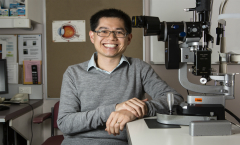
Opthalmologist Fred Chen is working on a bold new procedure for treating one of the most common causes of vision loss
A WA Health researcher is working on a bold new procedure for treating one of the most common causes of vision loss.
Royal Perth Hospital ophthalmologist Fred Chen believes his procedure may one day be capable of restoring vision in patients with age-related macular degeneration (AMD).
At the centre of his project is a unique three-layered eye patch that Dr Chen’s team is developing and that would be implanted into a patient’s retina.
Measuring about 12mm², the patch is created using adult stem cells extracted from the cornea of the patient’s own eye.
Though Dr Chen is not the only researcher looking at treating AMD with a stem cell-derived retinal patch, his approach is unique in that the patch consists of the patient’s own stem cells supported by blood vessels underneath a bio-artificial scaffold.
The scaffold, which supports retinal cells on one side and blood vessel cells on the other, creates the necessary physical support to enable delivery of these delicate structures.
Dr Chen’s previous human transplantation research supported the concept that including microvasculature would improve the graft’s integration as well as its long-term survival.
He also says there are advantages to using the patient’s own corneal cells over other types of cells such as embryonic or donor stem cells, including that they:
- can be turned directly into retinal cells, bypassing an intermediate stage that would be required if skin cells were used
- do not create ethical issues associated with using embryonic cells
- reduce the risk of rejection and need for immuno-supressing drugs, associated with mismatched donor cells.
Dr Chen said that while early investigations showed the patches were effective in preventing vision loss, human trials were several years away.
Using Dr Chen’s approach, once cells have been cut from the patient’s cornea, they are cultured in a laboratory for about two months before being implanted into the patient’s retina in surgery that Dr Chen anticipates could be done within an hour under local anaesthetic.
Dr Chen was one of 21 Western Australian researchers to share in $1.35 million of State Government funding under round three of the FutureHealth WA Merit Award program.
The grants enable researchers who narrowly missed out on National Health and Medical Research Council (NHMRC) grants to strengthen their applications and increase their prospects of securing NHMRC funding in future rounds.
Dr Chen will use his Merit Award to generate vital pilot data and find the optimal technique to culture the retinal cells and accompanying blood vessels.
Another aspect of Dr Chen’s research involves observation of the natural progression of macular degeneration to identify the optimal time at which a patient would benefit from such a procedure.
“You don’t want to wait until it the disease has progressed too far for the patch to be of real benefit, but you would also not want to perform it too early on a patient whose disease might not otherwise have progressed,” he says.